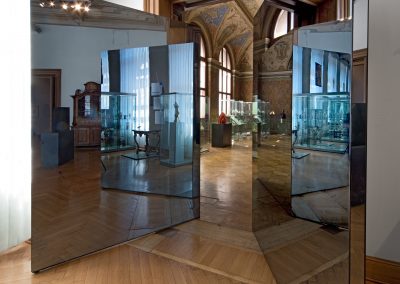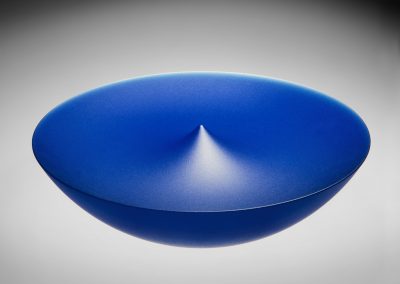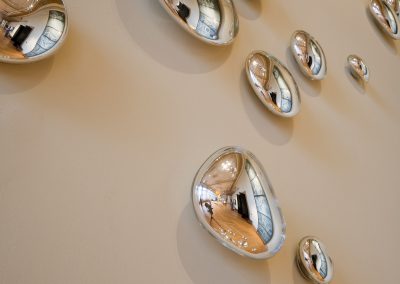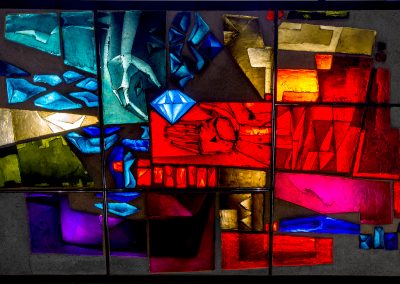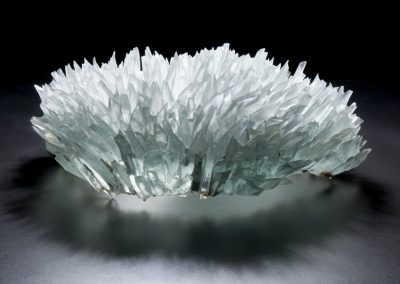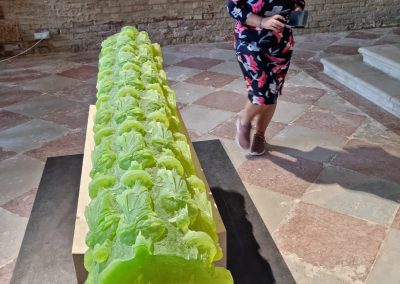

2.1. Sharing beauty
In this section, let us go to the exhibition together with the deaf children and learn about the phenomenon of Czech glass. The exhibition at the Museum of Decorative Arts in Prague showcases part of the world-famous collection of Czech glass from the second half of the 20th and the beginning of the 21st centuries, the so-called authorial glass. The exhibition is called Pleiad of Glass 1946–2019 (authorial glass) and provides visitors with a visual explanation of how and when these exclusive works of art initiated the emergence and development of authorial glass globally. The works do not age: they are still topical in terms of aesthetics, imaginative in their conception and innovative in terms of their execution and the technology used. https://www.upm.cz/plejady-skla-1946-2019/
Let us be enchanted by the splendour of the art of glass. Take a good look at the following examples.
2.2. Artefacts speak
What beauty! There are some things that we like and other things that we dislike: we often think that it is enough to call them beautiful or ugly. Is that all there is to it? We also think that we are the ones looking, but, in reality, it is just the opposite. Works of art look at us and invite us to talk to them. A work of art is a message, a complex statement that we learn to read. It is “written” in the language of an artistic medium and relates to our memories, experiences, sensibilities; it asks us questions and provokes our thinking. Whether it is soothing or unsettling, an artwork speaks.
In order for us to establish a relationship with the work, it is necessary to spend some time with it: a lot of time, actually. Some viewers like to walk in a group and talk about what they have seen; others prefer to talk to a work of art when they are alone. Still, some people want to engage in a creative dialogue with it – and that is the best experience. Remember emancipation and action that we talked about in the introduction to Lesson 1? After all, “all wanting to do is a wanting to say and this wanting to say is addressed to any reasonable being”.
Writing a poem can also be a way to understand a work of art; or to understand other people. We now have an interesting task for you. Eva and Aikaterini have written poems inspired by glass objects. Both young women are students of art education. Eva is Czech, Aikaterini came here from Ukraine. They have abandoned descriptive language and immersed themselves into the world of imagination. Take a look at the glass objects in the pictures below and read the poems. Can you tell which poem goes with which object?
Did you enjoy the Czech glass art with the poem? Then, let’s move on to the Reflection, where you can show your creativity.

Reflection 2.1
Now, it is your turn. Choose an object from Our glass gallery below and write a poem or a poetic text to it. Or compose a poem in your sign language. Record your ideas and experiences in your notebook. Then, you can share them with your friends through any social media. We encourage you to use AMASS MOOC hashtag (#AMASSMOOC) in your post to invite you to a socially engaged art community.
Credits & References
Images
Figure 2 – Václav Cigler, Michal Motyčka: Black Portal II, a, b (installation), 2019. Flat metalized glass, metal construction
© Václav Cigler, Michal Motyčka
© Photo: Gabriel Urbánek
By kind permission of The Museum of Decorative Arts in Prague
Figure 3 – František Vízner: Object, 1972. Cut and acid-etched glass
© František Vízner
© Photo: Gabriel Urbánek
By kind permission of The Museum of Decorative Arts in Prague
Figure 4 – Pavel Kopřiva: Local Problem, 2001. Installation assembled from blown, mirrored-glass parts
© Pavel Kopřiva
© Photo: Gabriel Urbánek
By kind permission of The Museum of Decorative Arts in Prague
Figure 5 – Stanislav Libenský, Jaroslava Brychtová: Fire and glass, 1960-61. Mould-melted glass, concrete panels, metal frame
© Stanislav Libenský, Jaroslava Brychtová
© Photo: Gabriel Urbánek
By kind permission of The Museum of Decorative Arts in Prague
Figure 6 – Klára Horáčková: Xiphosuran (Ostrorep), 2003. Fused chips of flat glass
© Klára Horáčková
© Photo: Gabriel Urbánek
By kind permission of The Museum of Decorative Arts in Prague
Figure 7 – Rony Plesl: Rony Plesl: Trees Grow from the Sky, 2022. Crystal glass, uranium glass. Josef Pleskot: Installation concept. Jiří Šín: Vitrum Vivum glassmaking technology. Site specific installation, Chiesa di Santa Maria della Visitazione. International Art Exhibition – La Biennale di Venezia, April – November , 2022
© Photo: Leonora Kitzbergerová, The fourth tree
Figure 8 – Crane
© Photo: Gabriel Urbánek
By kind permission of The Museum of Decorative Arts in Prague
Figure 9 – Aleš Vašíček: Symbol of the Sky, 1990. Kiln-cast, cut and acid-etched glass
© Photo: Gabriel Urbánek
By kind permission of The Museum of Decorative Arts in Prague
Figure 10 – Blue tubes
© Photo: Gabriel Urbánek
By kind permission of The Museum of Decorative Arts in Prague
References
Křen, I. (2006) Czech Glass / Studio Glass/ Permanent exhibition. East Bohemian Museum in Pardubice.

